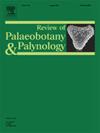Earliest thorny bamboo from Pleistocene of Asia characterizing spinescence and paleoclimatic adaptations in bamboos
IF 1.7
3区 地球科学
Q2 PALEONTOLOGY
引用次数: 0
Abstract
Spinescence—characterized by spines, prickles, and thorns—is a key defensive trait in plants, but is rare among bamboo genera. Its evolutionary history in bamboos remains poorly understood due to limited fossil evidence, with only a single previously documented specimen of a preserved node. Furthermore, the evolutionary ecology and paleoclimatic adaptations of bamboos during the Quaternary in Asia remain unclear due to a lack of fossil records. This study introduces Chimonobambusa manipurensis sp. nov., a well-preserved thorny bamboo fossil from the late Pleistocene of eastern India, marking the first Asian fossil record of thorny bamboo and the first Quaternary record from Asia. The fossil features nodes, internodes, nodal buds, and thorn scars, offering novel insights into bamboo spinescence and nodal morphology. C. manipurensis displays three well-preserved nodes, two complete internodes, prominently conserved nodal buds, and 3–4 thorn base scars along each nodal rim. Morphologically, it shares traits seen in modern Chimonobambusa Makino and is placed within the same genus. Together with a Pliocene–Pleistocene thorny bamboo record from Peru, this discovery suggests spinescence in bamboos likely emerged during the Neogene, with evolutionary adaptations continuing into the Pleistocene potentially as an adaptation to changing climatic conditions and increased herbivory pressures. Furthermore, it suggests that bamboos during Quaternary time in Asia were growing under warm and humid climatic conditions. This finding enhances our understanding of bamboo morphological evolution and paleoclimatic adaptations, filling a critical gap in the global fossil record.
亚洲更新世最早的带刺竹子,描述了竹子的棘和古气候适应性
刺——以刺、皮刺和刺为特征——是植物的关键防御特征,但在竹属中很少见。由于化石证据有限,它在竹子中的进化史仍然知之甚少,只有一个保存完好的节点的单一记录标本。此外,由于缺乏化石记录,亚洲第四纪竹子的进化生态和古气候适应尚不清楚。本研究引入了印度东部晚更新世保存完好的刺竹化石Chimonobambusa manipurensis sp. nov.,这是亚洲第一个刺竹化石记录,也是亚洲第一个第四纪记录。该化石具有节、节间、节芽和刺痕的特征,为研究竹子的棘和节形态提供了新的见解。C. manipurensis有三个保存完好的节,两个完整的节间,显著保存的节芽,每个节边缘有3-4个刺基部疤痕。在形态上,它与现代Chimonobambusa Makino具有相同的特征,并被置于同一属。再加上来自秘鲁的上新世-更新世多刺竹记录,这一发现表明,竹子的刺可能出现在新近纪,进化适应可能持续到更新世,以适应不断变化的气候条件和不断增加的食草压力。第四纪亚洲竹林生长在温暖湿润的气候条件下。这一发现增强了我们对竹子形态演化和古气候适应的认识,填补了全球化石记录的一个重要空白。
本文章由计算机程序翻译,如有差异,请以英文原文为准。
求助全文
约1分钟内获得全文
求助全文
来源期刊
CiteScore
3.50
自引率
21.10%
发文量
149
审稿时长
6 months
期刊介绍:
The Review of Palaeobotany and Palynology is an international journal for articles in all fields of palaeobotany and palynology dealing with all groups, ranging from marine palynomorphs to higher land plants. Original contributions and comprehensive review papers should appeal to an international audience. Typical topics include but are not restricted to systematics, evolution, palaeobiology, palaeoecology, biostratigraphy, biochronology, palaeoclimatology, paleogeography, taphonomy, palaeoenvironmental reconstructions, vegetation history, and practical applications of palaeobotany and palynology, e.g. in coal and petroleum geology and archaeology. The journal especially encourages the publication of articles in which palaeobotany and palynology are applied for solving fundamental geological and biological problems as well as innovative and interdisciplinary approaches.

 求助内容:
求助内容: 应助结果提醒方式:
应助结果提醒方式:


